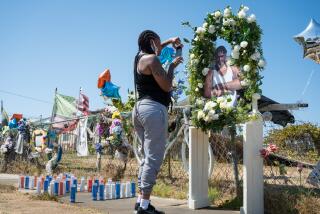Frustration and Anger Left in Killing’s Wake : Community: South-Central residents vent their feelings on the street after sheriff’s deputies shoot a Nation of Islam member to death.
- Share via
Four men stood in front of a corner liquor store, eyeing the police tape and Sheriff’s Department cars lining 106th Street, remnants of an incident that left one man dead, another wounded. And in frustration, they echoed a chorus of black rage that resounded from one end of the block to the other.
“People are tired of being beat up and shot at,” said one 39-year-old man who has spent his entire life in South-Central Los Angeles. “A lot of us feel we’d rather die and go to hell than accept this.”
The news traveled by word of mouth, fact mingled with rumor, anger clouded by disbelief. “They shot him seven times,” one said. “In the back,” said another.
Anita Cox, 30, gazed at a poster in an apartment window promoting the upcoming visit of Muslim leader Louis Farrakhan. “I heard Farrakhan is going to come down here and make his speech in the middle of the street,” she said. “That’s the word.”
Some of the residents had been up all night, kept awake by the sound of helicopters and squad cars blaring down their street after a sheriff’s deputy shot to death a 27-year-old member of the Nation of Islam and wounded another during an altercation after a traffic stop.
The neighbors clustered Tuesday--in their front yards, on the sidewalk, around a puddle of blood spilled during the incident and left to dry in the morning sun. They were angry, and sad, and frustrated.
“I don’t know what to feel,” said Johnnie Johnson, 30. “Everybody feels the same way. They just get tired of it.”
Hours after the shooting, five sheriff’s cars remained on the street. Orange cones blocked cars traveling down Vermont Avenue, and yellow tape marked the spot where the incident occurred.
“The way they’re doing now, they’re going to have to face the wrath of the people,” one man said. “I feel this ain’t nothing but a police state.”
A 34-year-old woman named Ann said she saw the incident from her apartment window. “We just heard the poor man shouting for mercy,” she said, shaking her head. “They were steady beating him.”
“They could have used a stun gun,” said Don Franklin, 30. “They too damn trigger-happy for me.
“If they shoot one of them,” Franklin said, “what makes you think they won’t shoot one of us?”
A Welcome Sight
The neighbors said they could not keep the graffiti off the buildings or the drug dealing off the street before the Nation of Islam came along. They were a welcome sight, in their characteristic suits and bow ties, always courteous, always respectful.
“Those Muslims recruited those gang-bangers who were selling dope and put them in suits,” Ann said. “They cleaned those boys up, taught them to respect themselves. I don’t know what caused this, but I know what the Muslims did for our neighborhood. They cleaned it up.”
“I’ve lived here nine years,” said Cox, mother of a 10-year-old. “When they were over there selling dope, nobody got killed. Put suits on them, and (sheriff’s deputies) kill them.”
The sound of gunshots put fear in one mother’s heart. “I have five sons of my own and a daughter,” said Ruthie Collins, 47, whose grown children live around the corner from her. “As soon as I heard the shooting, I got on the phone to make sure they were safe.
“It’s scary. . . . They killed this man and wounded another and they can sit there and drink coffee and eat doughnuts.”
Down the street, deputies milled about, completing their field investigation, while Nation of Islam members snapped photos of the scene from an apartment house balcony.
Residents said they were made to feel as though they had done something wrong, unable to get to their homes without showing identification, unable to leave because their street had been barricaded. Gwendolyn Cain and other neighbors wondered if their treatment would have been different had they lived in Beverly Hills--or been another color.
“They wouldn’t let us leave,” said Cain, 27. “I had to miss work because of something they did.”
By noon, the street seemed to return to normal. The tape was gone, the cones had disappeared, and most of the residents had gone about their daily business. But the blood on the sidewalk still remained. As did the anger. And the questions.
“They (deputies) know they messed up,” said Cox, turning to go inside her home. “They’re used to a slap on the hand, but I don’t think so this time. They’re going to have to explain this one.”
More to Read
Sign up for Essential California
The most important California stories and recommendations in your inbox every morning.
You may occasionally receive promotional content from the Los Angeles Times.













